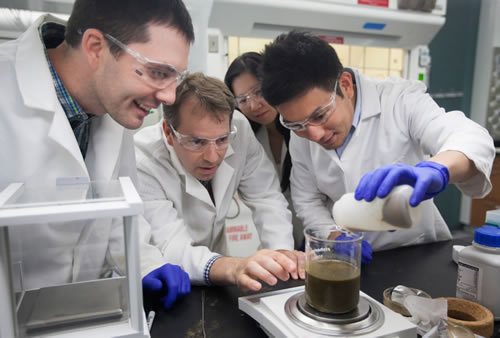Earth’s petroleum stores are dwindling, but a Wisconsin project aims to produce energy from a resource that’s in little danger of running low: cow manure, or “brown gold.”
The University of Wisconsin–Madison and several state companies, funded by a $7 million grant from the USDA Biomass Research and Development Initiative (BRDI), have partnered to pilot the conversion of dairy farm manure into useful product streams—a project that is expected to have significant environmental and economic benefits.
The Accelerated Renewable Energy (ARE) project is in progress at the 5,000-cow Maple Leaf Dairy in Manitowoc County, where animal waste is separated into different streams, or fractions, of processed manure.
After small plant fibers in the manure are separated and anaerobically digested to biogas, liquids from the digestion process are used to fertilize crops, while solids can be converted into useful chemicals and bio-plastics. Larger plant fibers make great animal bedding and mulch, not to mention a starting material for ethanol fermentation.
 Meanwhile, at the new Wisconsin Energy Institute at UW–Madison, project co-investigator Troy Runge, a CALS professor of biological systems engineering, is analyzing the ARE project’s separation techniques to improve their efficiency. “We are performing many of the same separations that occur on the farm, but in the controlled environment of
Meanwhile, at the new Wisconsin Energy Institute at UW–Madison, project co-investigator Troy Runge, a CALS professor of biological systems engineering, is analyzing the ARE project’s separation techniques to improve their efficiency. “We are performing many of the same separations that occur on the farm, but in the controlled environment of
the lab to both measure and optimize the system,” says Runge.
Tom Cox, a project collaborator and a CALS professor of agricultural economics, sees great potential for the initiative. “This is a triple-win situation; we would like to make money by doing the right thing by the environment and society,” he says.
Aicardo Roa-Espinosa MS’85 PhD’89, president of partner SoilNet LLC and an adjunct faculty member in biological systems engineering, developed the manure separation technology behind the project. Roa-Espinosa and Runge will monitor the quality, quantity and composition of biogas produced and analyze processed manure streams to identify chemical constituents. Student researchers will conduct life cycle assessments to evaluate the project’s environmental impact.
The goal for the four-year grant, researchers say, is to improve these manure separation technologies until their sustainability benefits can be realized on a broader commercial scale.
Runge notes that the public-private, multidisciplinary project exemplifies what the university hopes to do with the Wisconsin Energy Institute. “It’s also an example of a project that’s important to Wisconsin,” he says.
Indeed, the project may help farmers manage manure with benefits for both the environment and human health. A 5,000-cow dairy farm like Maple Leaf produces approximately 25 tons of manure per day, which require millions of gallons of water to manage. Although some manure may be used as fertilizer, nutrient imbalances and runoff can create environmental problems. However, manure processed using SoilNet’s technology yields concentrated, homogenized fertilizer that can be applied with greater control over nutrient content.
In addition to its environmental benefits, the cellulosic—or non-food—plant biomass derived from dairy manure avoids the conflict of “food versus fuel.”
That’s a promising basis for exciting innovations at dairy farms. For ARE project leaders, farms are not only the heart of agriculture. They also have the potential to serve as foundations for cellulosic biorefineries that could prove key in supporting a local green economy and a sustainable energy system throughout the region.

Shane Mathis (left), an undergraduate researcher, Troy Runge (middle left), Biological Systems Engineering (BSE) faculty member, and Kim Huong Pham (middle right), a master’s student in the College of Agricultural and Life Sciences (CALS) examine a manure sample being prepared for separation by Zong Liu (right), a Ph.D. student in the CALS, in Runge’s lab in the Wisconsin Energy Institute in Madison, Wis., Tuesday, June 11, 2013. Photo: Matthew Wisniewski – Wisconsin Energy Institute
